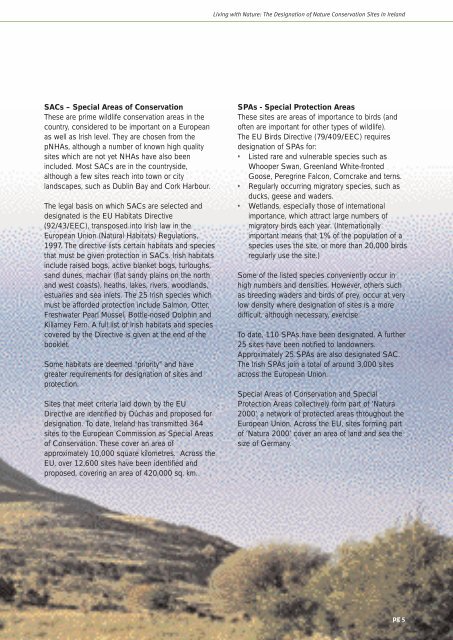The Designation of Nature Conservation Sites in Ireland
The Designation of Nature Conservation Sites in Ireland
The Designation of Nature Conservation Sites in Ireland
You also want an ePaper? Increase the reach of your titles
YUMPU automatically turns print PDFs into web optimized ePapers that Google loves.
Liv<strong>in</strong>g with <strong>Nature</strong>: <strong>The</strong> <strong>Designation</strong> <strong>of</strong> <strong>Nature</strong> <strong>Conservation</strong> <strong>Sites</strong> <strong>in</strong> <strong>Ireland</strong><br />
SACs – Special Areas <strong>of</strong> <strong>Conservation</strong><br />
<strong>The</strong>se are prime wildlife conservation areas <strong>in</strong> the<br />
country, considered to be important on a European<br />
as well as Irish level. <strong>The</strong>y are chosen from the<br />
pNHAs, although a number <strong>of</strong> known high quality<br />
sites which are not yet NHAs have also been<br />
<strong>in</strong>cluded. Most SACs are <strong>in</strong> the countryside,<br />
although a few sites reach <strong>in</strong>to town or city<br />
landscapes, such as Dubl<strong>in</strong> Bay and Cork Harbour.<br />
<strong>The</strong> legal basis on which SACs are selected and<br />
designated is the EU Habitats Directive<br />
(92/43/EEC), transposed <strong>in</strong>to Irish law <strong>in</strong> the<br />
European Union (Natural Habitats) Regulations,<br />
1997. <strong>The</strong> directive lists certa<strong>in</strong> habitats and species<br />
that must be given protection <strong>in</strong> SACs. Irish habitats<br />
<strong>in</strong>clude raised bogs, active blanket bogs, turloughs,<br />
sand dunes, machair (flat sandy pla<strong>in</strong>s on the north<br />
and west coasts), heaths, lakes, rivers, woodlands,<br />
estuaries and sea <strong>in</strong>lets. <strong>The</strong> 25 Irish species which<br />
must be afforded protection <strong>in</strong>clude Salmon, Otter,<br />
Freshwater Pearl Mussel, Bottle-nosed Dolph<strong>in</strong> and<br />
Killarney Fern. A full list <strong>of</strong> Irish habitats and species<br />
covered by the Directive is given at the end <strong>of</strong> the<br />
booklet.<br />
Some habitats are deemed “priority” and have<br />
greater requirements for designation <strong>of</strong> sites and<br />
protection.<br />
<strong>Sites</strong> that meet criteria laid down by the EU<br />
Directive are identified by Dúchas and proposed for<br />
designation. To date, <strong>Ireland</strong> has transmitted 364<br />
sites to the European Commission as Special Areas<br />
<strong>of</strong> <strong>Conservation</strong>. <strong>The</strong>se cover an area <strong>of</strong><br />
approximately 10,000 square kilometres. Across the<br />
EU, over 12,600 sites have been identified and<br />
proposed, cover<strong>in</strong>g an area <strong>of</strong> 420,000 sq. km.<br />
SPAs - Special Protection Areas<br />
<strong>The</strong>se sites are areas <strong>of</strong> importance to birds (and<br />
<strong>of</strong>ten are important for other types <strong>of</strong> wildlife).<br />
<strong>The</strong> EU Birds Directive (79/409/EEC) requires<br />
designation <strong>of</strong> SPAs for:<br />
• Listed rare and vulnerable species such as<br />
Whooper Swan, Greenland White-fronted<br />
Goose, Peregr<strong>in</strong>e Falcon, Corncrake and terns.<br />
• Regularly occurr<strong>in</strong>g migratory species, such as<br />
ducks, geese and waders.<br />
• Wetlands, especially those <strong>of</strong> <strong>in</strong>ternational<br />
importance, which attract large numbers <strong>of</strong><br />
migratory birds each year. (Internationally<br />
important means that 1% <strong>of</strong> the population <strong>of</strong> a<br />
species uses the site, or more than 20,000 birds<br />
regularly use the site.)<br />
Some <strong>of</strong> the listed species conveniently occur <strong>in</strong><br />
high numbers and densities. However, others such<br />
as breed<strong>in</strong>g waders and birds <strong>of</strong> prey, occur at very<br />
low density where designation <strong>of</strong> sites is a more<br />
difficult, although necessary, exercise.<br />
To date, 110 SPAs have been designated. A further<br />
25 sites have been notified to landowners.<br />
Approximately 25 SPAs are also designated SAC.<br />
<strong>The</strong> Irish SPAs jo<strong>in</strong> a total <strong>of</strong> around 3,000 sites<br />
across the European Union.<br />
Special Areas <strong>of</strong> <strong>Conservation</strong> and Special<br />
Protection Areas collectively form part <strong>of</strong> ‘Natura<br />
2000’, a network <strong>of</strong> protected areas throughout the<br />
European Union. Across the EU, sites form<strong>in</strong>g part<br />
<strong>of</strong> ‘Natura 2000’ cover an area <strong>of</strong> land and sea the<br />
size <strong>of</strong> Germany.<br />
pg 5
















